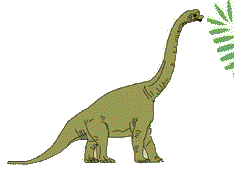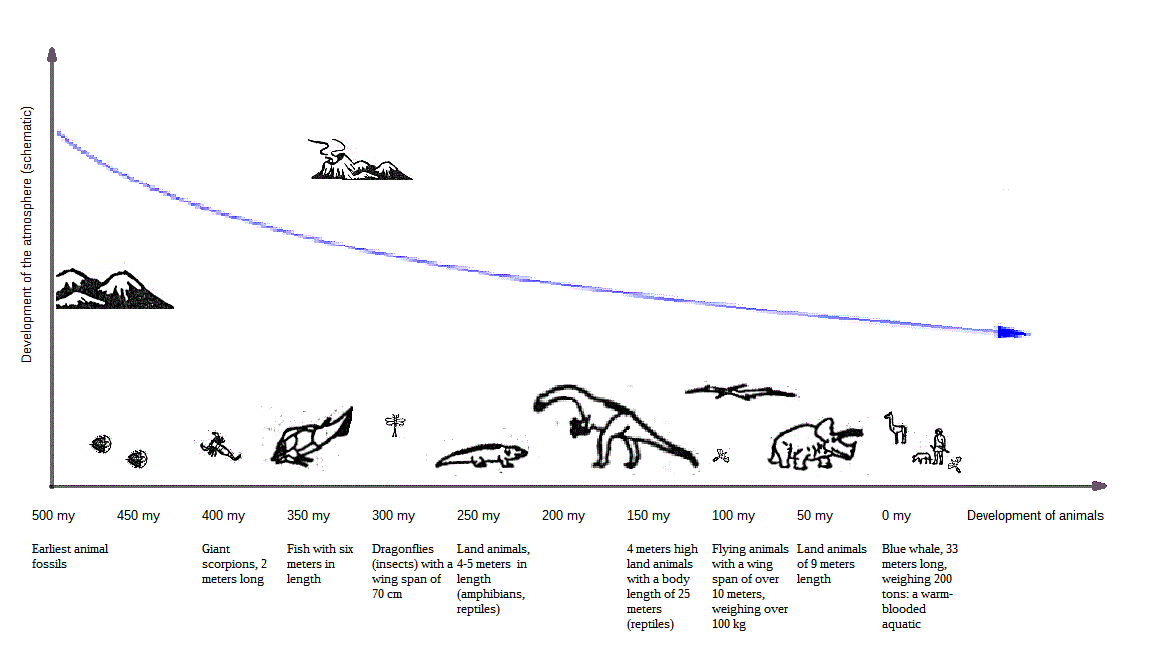
The extinction of
the dinosaurs
Tom from ?? wrote:
-
Studies of coal layers from 200 to 300 million years ago in
Greenland and Antarctica show abundant amounts of plant remains, but today
these areas are covered with ice and the average temperatures are well below
freezing. How are those areas able to account for the plant abundance?
- There are many theories regarding the extinction of dinosaurs due to the drift, what are some of your theories. I would be interested in learning these.
My answer:
Your question is a difficult one. Personally, as a layman, I have no direct theory about the extinction of the dinosaurs. There may be some truth in the meteorite impact theory, but that would possibly account only for the final kill and not for the seemingly gradual decline over a long biological period of time.
However, what is interesting is the fact that fossil remains of animals and plants, as you say, have been found in the polar regions that today would survive only in the tropics.
The only probable explanation is that the climate in those parts - not so long ago in geological times - was much warmer than today. There could be two explanations:
Explanation 1:
The whole of the earth was warmer, due to
-
a greater intensity of the sun, as proposed by ALBIN FISHER and described
in German - translate on my global warming page
on my global warming page
See also: The Vostok Ice Cores Revisited Part I and Part II - a detailed investigation into the correlation of temperature and atmospheric carbon dioxide over the last 500 million years.
-
a greater carbon dioxide concentration the atmosphere, possibly caused by
higher volcanic activity over a longer period of time
-
a greater - how should I say? - amount of atmosphere on this planet,
causing higher insulation, as proposed by me
in German - translate on my archaeopteryx
page
on my archaeopteryx
page
What leads me to this assumption?
Well, the question to me is not what killed
the dinosaurs, but
Scientists have it that even if you would clone a dinosaur nowadays, it would be difficult to keep it alive. It would probably starve and freeze to death and never reproduce in most parts of the world today.
And putting that aside, assuming they kept to the warm and moist regions of the planet wherever
these happened to be and migrated with them, there remain
-
 For
one, scientist have been unable to explain, so I have heard, how so large and primitive
animals with extremely long necks and relatively small nostrils were able
to breathe sufficient air to sustain their metabolism.
For
one, scientist have been unable to explain, so I have heard, how so large and primitive
animals with extremely long necks and relatively small nostrils were able
to breathe sufficient air to sustain their metabolism.
-
 Furthermore,
I ask the question of why certain animals, handicapped by reptile metabolism
and skin wings, were able to fly with the wing
span and weight of a modern ultralight or glider aeroplane, a feat impossible
today even for high-metabolism, feather-winged birds - which in turn
evolved from dinosaurial ancestors - or rather, which these evolved
into to adapt to certain changes.
Furthermore,
I ask the question of why certain animals, handicapped by reptile metabolism
and skin wings, were able to fly with the wing
span and weight of a modern ultralight or glider aeroplane, a feat impossible
today even for high-metabolism, feather-winged birds - which in turn
evolved from dinosaurial ancestors - or rather, which these evolved
into to adapt to certain changes.
What could these changes have been?
In general, large, scaly, slow-metabolism animals dependent on external heat gave way to smaller animals generating their own body warmth and insulated by fur and feathers more able to live in the cold - and, as I propose, to breathe in a thinner atmosphere.
( Although new fossil evidence seems to suggest that some dinosaurs may be more warm - blooded than we think; at least some of them seem to have had a heart resembling that of a mammal. In any case, since birds have evolved directly from these creatures, there must at least been some possibility of transition. Which would then beg the question: did the dinosaurs in the arctic regions carry fur or feathers? )
However, going back even further in time, fossil records have been found of insects - dragonflies (Meganeura) - the size of cats! Insects are even more dependent on atmospheric pressure and density to breathe and fly ( they do not exactly fly, but "swim" through the surrounding air ), and what size are they today? Feathered Archaeopteryx itself, one of the first bird - like creatures, was even a bit smaller than they, being about the size of a pigeon or magpie. Now compare it to the huge flying reptiles that went before, and you will see that flying animals of all denominations have steadily become smaller in size and lighter in weight over time, sometimes quite drastically. The same goes for plants and land-bound creatures.
-
 So, all in all I propose that the height, volume,
density and pressure of the earth's atmosphere may once have been
two or three times that of today, perhaps indeed caused by a higher amount of
carbon dioxide in the atmosphere ( which on the other hand would hamper respiration
for the animals of that time ) possibly varying through time due to volcanic activity,
but generally waning through the ages, perhaps being blown into space
by the solar wind and / or heavy meteorite impacts.
So, all in all I propose that the height, volume,
density and pressure of the earth's atmosphere may once have been
two or three times that of today, perhaps indeed caused by a higher amount of
carbon dioxide in the atmosphere ( which on the other hand would hamper respiration
for the animals of that time ) possibly varying through time due to volcanic activity,
but generally waning through the ages, perhaps being blown into space
by the solar wind and / or heavy meteorite impacts.
-
More carbon dioxide would finally, however, lead to more atmospheric oxygen as well
via photosynthesis. Its retention period within the atmosphere is nowadays measured in decades.
And it would allow for more (and probably taller) plants, or plant growth, for animals to feed upon.
-
The amount of carbon dioxide trapped in limestone and other carbonated rock for millions of years,
if released by volcanoes, would raise the earth's atmospheric pressure to 50 or 60 times
the amount it is today; so releasing but a fraction of that would easily raise the
atmospheric pressure two to three times the current value - thus raising the mean temperature,
filtering out more UV light rays, increasing water vapor, etc. etc. Things were not always as they are now.

-
Some things change: Added from the BBC, 2017
The Paleocene-Eocene Thermal Maximum
About 50m years ago, global temperatures rose more than 5 C on average and stayed that way for over 100,000 years, with the surface of seas in the Arctic being as warm as those in the subtropics. There were widespread extinctions, changes in ocean currents, and there was much less oxygen in the sea depths. The rise has been attributed to an increase of carbon dioxide and methane in the atmosphere.
Feathered Dinosaurs
In the last century, discoveries of fossils with feathers established that at least some dinosaurs were feathered and that some of those survived the great extinctions and evolved into the birds we see today.
Animals who had grown too large to adapt simply slowly suffocated over time; smaller animals with higher metabolism rates survived. . . if this is true, it may still be going on, and the consequences are dire. Some day our heads will be sticking out into space. . . Maybe fish, centipedes, crabs, spiders, insects and other creepy-crawlies were only able to heave themselves on dry land at all in a much denser atmosphere, since then their water-oxygen breathing apparatus could handle air-borne oxygen at a greater atmospheric pressure than today - and afterwards grow to preposterous size. It should not be too difficult for engineers and biologists to calculate what atmospheric pressure would be needed to allow prehistoric creatures of known size or wing span and weight to breathe and fly by extrapolating known values for to-day. I just think no one has tried yet.
A simple increase of atmospheric oxygen might alleviate the breathing problem, but it would not relieve the weight / flight problem, while causing spontaneous forest fires reducing the oxygen level below that specific threshold again - which at the moment, as we know, is around 20%.
But, of course, that could be the totally wrong perspective. It is not that once upon a time the plants and animals were bigger than they are today; it is that nowadays they are all smaller than they once were.
Perhaps today only the whale is able to support such a huge body for the fact that once in a while it dives and therefore presses its blood the oxygen into its body cells via the surrounding water pressure. Who knows? That is for other people to find out.
By the way: I have the idea that even the mountains may have been higher, as it seems to me to be no pure coincidence that their highest peaks hardly protrude out of the troposphere. Erosion rates get high once the protective covering is missing. . . it is the same effect as islands being washed flat by the Surf. *
Radically speaking, there is no such thing as coincidence - but
this is just my personal interpretation of the "chaos theory" which simply
states that the things are as they are because under the given circumstances
there is no other way for them to be. The question to be asked is: what are
these specific circumstances, and what would the circumstances of other states
be like?
* On the other hand, there may be another natural limitation to the height of mountains at about 10 000 meters ( and the depth of deep-sea trenches to the same amount ): their own weight and density in relation to that of the earth's mantle. The mountains and, indeed, the continents are of light-weight rock that sinks into the mantle - which, incidentally, is liquefied amongst other causes by sheer pressure of weight - just as a ship sinks into the ocean until equilibrium is achieved; and so the valleys of mountain ranges near the poles in Scandinavia and southernmost America, once suppressed below sea level by thousands of meters of ice covering, are still rising out of the sea. One day the fjords will be no more.
None of these theories exclude the other!
If it was warmer on this planet as a whole,
points a ) and
b ) would probably have the effect of great
deserts in the tropics of today, simply moving the tropic belts to the poles,
while point c )
would probably have spread the warmth more evenly across the planet through
more intensive and voluminous winds - an effect we are again seeing
today - these in turn enabling bigger creatures to fly from higher cliffs
- which is one of the reasons I believe in it ( - and, of
course, because I also believe I thought of it, which makes me inclined to
do so!
![]()
Explanation 2:
Not the whole of the earth was necessarily warmer, but some parts, like Antarctica, were.
Well, this would not explain why the Arctic should have been warmer too ( there is no such thing as coincidence. . . ), but, of course, there may have been some other common cause.
Two possibilities come to mind: these places have moved away from the equator, or the heat-transporting ocean streams have.
![]() The way I have worked it out, Antarctica has during the time in question
been more or less around the same latitude, spinning around more than anything
else and moving south just slightly; but it was once connected to the other
continents, and had a direct connection to the China of today. If you take
the trouble to re-arrange the continental fragments in such a way that the
fossil records of today form coherent belts,
you will see what I mean.
The way I have worked it out, Antarctica has during the time in question
been more or less around the same latitude, spinning around more than anything
else and moving south just slightly; but it was once connected to the other
continents, and had a direct connection to the China of today. If you take
the trouble to re-arrange the continental fragments in such a way that the
fossil records of today form coherent belts,
you will see what I mean.
The coal layers of China can be directly connected to those in other continents,
as well as can mass fossil finds of extinct species, the remains of which
today are separated by oceans impossible to cross. And as we all know since
Darwin, separating a herd of a species leads to divergence quite a short
time. And the fossil finds around the world are surprisingly consistent.
However, this does not explain their extinction, nor their existence over millions of years.
If, as I say, the overall climate is not strongly influenced by the arrangement of continents, oceans and atmosphere ( though maybe by their sheer amount ) local climates, however, are. In this sense, the closing of the Drake Straits ( the straits of Cape Horn ), again 50 - 40 million years ago, deflecting even more cold water northwards, ( again maybe during the lower sea levels of the ice ages, at least somewhat ), would have had a pronounced effect on the climate of parts of the Antarctic by diverting the cold streams northwards and drawing warm streams in return; but as I say, this would have been a very local effect such as has the gulf stream; nice for the creatures living in its influence, but not very important on a planetary scale; although some scientist say this is not so.
The same applies for the precession of the earth's axis, causing different parts of this planet being intensely shone upon by the sun through the ages. Of course, sun-loving creatures would have flocked there, and fled the darker and colder regions; and therefore would not have been in both places at the same time.
My personal belief is that the short-term heat balance of this planet is solely influenced by the amount of heat coming in ( intensity of the sun ) minus the amount leaving it again ( insulation by the atmosphere ) ; and to account for the dinosaurs once having inhabited regions on this planet now devoid of even the hardiest of creatures, in fact almost devoid of live altogether due to a shortage of warmth, it can only mean that either the intensity of the sun's radiation hitting this planet has waned, or its insulating cover, or both; and that this may still be going on. As a whole, this planet is still cooling off - and, as I assume, still loosing its atmosphere.
To picture the scale of time involved, here's a geologic time table I've just re-edited - hopefully with not too many mistakes.


 me!
me!